Ionospheric Oscillation with Periods of 6–30 Days at Middle Latitudes: A Response to Solar Radiative, Geomagnetic, and Lower Atmospheric Forcing
Abstract
1. Introduction
2. Data and Methods
3. Results
3.1. Periodic Variations in Solar and Geomagnetic Activity
3.2. The Relationship between Solar or Geomagnetic Activity and Ionospheric Oscillation
3.3. A Quasi-27-Day Oscillation Forced by Lower Atmospheric Dynamics
4. Discussion
5. Conclusions
- The 27-day ionospheric oscillations are strongest and have a high correlation coefficient with the solar flux index F10.7 but have a small decrease in correlation at the solar minimum stage. However, the correlation coefficients between the ionospheric oscillations and Kp index have a significant increase at the solar minimum stage. This results in a relatively even interannual distribution of the 27-day ionospheric oscillations. It indicates that the solar EUV radiations and recurrent geomagnetic activity associated with the high-speed streams/CIRs have a combined effect on the ionospheric oscillations with periods near solar rotation.
- The ionospheric oscillations with periods shorter than 20 days correlate better with the Kp index. This type of ionospheric oscillation occurs mostly at the minimum solar stage. And the correlation coefficient between the Kp index and TEC also has a significant increase at the minimum solar stage. This indicates that these ionospheric oscillations are most likely caused by coronal hole high-speed streams and CIRs.
- The spectral peak with periods of 27 days in TEC over the Wuhan area corresponds to the periodic variations of the F10.7 and Kp index of the corresponding periods. However, the spectral peak with periods shorter than 20 days in TEC over the Wuhan area did not have dominating spectral peaks. The mid-latitude ionosphere exhibits unique regional properties, which did not respond well to the Kp oscillation with periods shorter than 20 days.
- A quasi-27-day ionospheric oscillation caused by variations in the lower atmosphere dynamical process was studied. According to zonal winds model data from SD-WACCM-X, the quasi-27-day oscillation event was found have a peak amplitude in the lower atmosphere (the MLT region), which indicates that this oscillation is generated by the lower atmospheric PWs and propagates upwards. Moreover, similar oscillations were also found in the OLR, which represents the convective activity, suggesting that this oscillation may be forced by convective activity.
Author Contributions
Funding
Data Availability Statement
Acknowledgments
Conflicts of Interest
References
- Xu, J.; Wang, W.; Zhang, S.; Liu, X.; Yuan, W. Multiday thermospheric density oscillations associated with variations in solar radiation and geomagnetic activity. J. Geophys. Res. Space Phys. 2015, 120, 3829–3846. [Google Scholar] [CrossRef]
- Bartels, J. Twenty-seven day recurrences in terrestrial-magnetic and solar activity, 1923–1933. J. Geophys. Res. 1934, 39, 201. [Google Scholar] [CrossRef]
- Kutiev, I.; Otsuka, Y.; Pancheva, R.; Heelis, R. Response of low-latitude ionosphere to medium-term changes of solar and geomagnetic activity. J. Geophys. Res. Space Phys. 2012, 117. [Google Scholar] [CrossRef]
- von Savigny, C.; Peters, D.H.W.; Entzian, G. Solar 27-day signatures in standard phase height measurements above central Europe. Atmos. Chem. Phys. 2019, 19, 2079–2093. [Google Scholar] [CrossRef]
- Rich, F.J. The 27-day variations of plasma densities and temperatures in the topside ionosphere. J. Geophys. Res. 2003, 108. [Google Scholar] [CrossRef]
- Min, K.; Park, J.; Kim, H.; Kim, V.; Kil, H.; Lee, J.; Rentz, S.; Lühr, H.; Paxton, L. The 27-day modulation of the low-latitude ionosphere during a solar maximum. J. Geophys. Res. Space Phys. 2009, 114. [Google Scholar] [CrossRef]
- Xu, J.; Wang, W.; Lei, J.; Sutton, E.K.; Chen, G. The effect of periodic variations of thermospheric density on CHAMP and GRACE orbits. J. Geophys. Res. Space Phys. 2011, 116. [Google Scholar] [CrossRef]
- Hansen, R.T.; Hansen, S.F.; Sawyer, C. Long-lived coronal structures and recurrent geomagnetic patterns in 1974. Planet. Space Sci. 1976, 24, 381–388. [Google Scholar] [CrossRef]
- Tsurutani, B.T.; Gonzalez, W.D.; Gonzalez, A.L.C.; Guarnieri, F.L.; Gopalswamy, N.; Grande, M.; Kamide, Y.; Kasahara, Y.; Lu, G.; Mann, I.; et al. Corotating solar wind streams and recurrent geomagnetic activity: A review. J. Geophys. Res. 2006, 111. [Google Scholar] [CrossRef]
- Lei, J.; Thayer, J.P.; Forbes, J.; Sutton, E.; Nerem, R.S.; Temmer, M.; Veronig, A. Global thermospheric density variations caused by high-speed solar wind streams during the declining phase of solar cycle 23. J. Geophys. Res. Space Phys. 2008, 113. [Google Scholar] [CrossRef]
- Wang, W.; Lei, J.; Burns, A.G.; Qian, L.; Solomon, S.C.; Wiltberger, M.; Xu, J. Ionospheric Day-to-Day Variability Around the Whole Heliosphere Interval in 2008. Sol. Phys. 2011, 274, 457–472. [Google Scholar] [CrossRef]
- Sojka, J.J.; McPherron, R.L.; van Eyken, A.P.; Nicolls, M.J.; Heinselman, C.J.; Kelly, J.D. Observations of ionospheric heating during the passage of solar coronal hole fast streams. Geophys. Res. Lett. 2009, 36. [Google Scholar] [CrossRef]
- Ma, Z.; Gong, Y.; Zhang, S.; Xue, J.; Luo, J.; Zhou, Q.; Huang, C.; Huang, K.; Yu, Y.; Li, G. Study of a Quasi-27-Day Wave in the MLT Region During Recurrent Geomagnetic Storms in Autumn 2018. J. Geophys. Res. Space Phys. 2021, 126. [Google Scholar] [CrossRef]
- Yu, B.; Scott, C.J.; Xue, X.; Yue, X.; Chi, Y.; Dou, X.; Lockwood, M. A Signature of 27 day Solar Rotation in the Concentration of Metallic Ions within the Terrestrial Ionosphere. Astrophys. J. Lett. 2021, 916, 106. [Google Scholar] [CrossRef]
- Jiang, G.; Wang, W.; Xu, J.; Yue, J.; Burns, A.G.; Lei, J.; Mlynczak, M.G.; Rusell, J.M. Responses of the lower thermospheric temperature to the 9 day and 13.5 day oscillations of recurrent geomagnetic activity. J. Geophys. Res. Space Phys. 2014, 119, 4841–4859. [Google Scholar] [CrossRef]
- Hoffmann, C.G.; von Savigny, C. Indications for a potential synchronization between the phase evolution of the Madden–Julian oscillation and the solar 27-day cycle. Atmos. Chem. Phys. 2019, 19, 4235–4256. [Google Scholar] [CrossRef]
- Schanz, A.; Hocke, K.; Kämpfer, N. On forced and free atmospheric oscillations near the 27-day periodicity. Earth Planets Space 2016, 68, 97. [Google Scholar] [CrossRef]
- Sukhodolov, T.; Rozanov, E.; Ball, W.T.; Peter, T.; Schmutz, W. Modeling of the middle atmosphere response to 27-day solar irradiance variability. J. Atmos. Sol.-Terr. Phys. 2017, 152–153, 50–61. [Google Scholar] [CrossRef]
- de Abreu, A.J.; Fagundes, P.R.; Bolzan, M.J.A.; de Jesus, R.; Pillat, V.G.; Abalde, J.R.; Lima, W.L.C. The role of the traveling planetary wave ionospheric disturbances on the equatorial F region post-sunset height rise during the last extreme low solar activity and comparison with high solar activity. J. Atmos. Sol.-Terr. Phys. 2014, 113, 47–57. [Google Scholar] [CrossRef]
- Hu, L.; Yue, X.; Ning, B. Development of the Beidou Ionospheric Observation Network in China for space weather monitoring. Space Weather 2017, 15, 974–984. [Google Scholar] [CrossRef]
- Yang, H.; Yang, X.; Zhang, Z.; Zhao, K. High-Precision Ionosphere Monitoring Using Continuous Measurements from BDS GEO Satellites. Sensors 2018, 18, 714. [Google Scholar] [CrossRef]
- Yang, Z.; Gu, S.Y.; Qin, Y.; Teng, C.K.M.; Huang, F.; Sun, W.; Dou, X. Statistical Study of F-Region Short Period Ionospheric Disturbances Related to Convection in the Lower Atmosphere Over Wuhan, China. Space Weather 2022, 20. [Google Scholar] [CrossRef]
- Cheng, H.; Huang, K.; Liu, A.Z.; Zhang, S.; Huang, C.; Gong, Y. A quasi-27-day oscillation activity from the troposphere to the mesosphere and lower thermosphere at low latitudes. Earth Planets Space 2021, 73, 183. [Google Scholar] [CrossRef]
- Liu, H.L.; Bardeen, C.G.; Foster, B.T.; Lauritzen, P.; Liu, J.; Lu, G.; Marsh, D.R.; Maute, A.; McInerney, J.M.; Pedatella, N.M.; et al. Development and Validation of the Whole Atmosphere Community Climate Model With Thermosphere and Ionosphere Extension (WACCM-X 2.0). J. Adv. Model. Earth Syst. 2018, 10, 381–402. [Google Scholar] [CrossRef]
- Atmospheric Chemistry Observations & Modeling (ACOM)/National Center for Atmospheric Research/University Corporation for Atmospheric Research, and Climate and Global Dynamics (CGD) Division/National Center for Atmospheric Research/University Corporation for Atmospheric Research. 2018. Available online: https://escomp.github.io/CESM/ (accessed on 11 July 2022).
- Gelaro, R.; McCarty, W.; Suárez, M.J.; Todling, R.; Molod, A.; Takacs, L.; Randles, C.A.; Darmenov, A.; Bosilovich, M.G.; Reichle, R.; et al. The Modern-Era Retrospective Analysis for Research and Applications, Version 2 (MERRA-2). J. Clim. 2017, 30, 5419–5454. [Google Scholar] [CrossRef]
- MERRA2 Global Atmosphere Forcing Data [Dataset] (Updated Irregularly). Research Data Archive at the National Center for Atmospheric Research, Computational and Information Systems Laboratory. Available online: https://rda.ucar.edu/datasets/ds313.3/ (accessed on 14 June 2022).
- Kane, R.P. Fluctuations in the ∼27-day sequences in the solar index F10 during solar cycles 22–23. J. Atmos. Sol.-Terr. Phys. 2003, 65, 1169–1174. [Google Scholar] [CrossRef]
- Ren, D.; Lei, J.; Wang, W.; Burns, A.; Luan, X.; Dou, X. Does the Peak Response of the Ionospheric F 2 Region Plasma Lag the Peak of 27-Day Solar Flux Variation by Multiple Days? J. Geophys. Res. Space Phys. 2018, 123, 7906–7916. [Google Scholar] [CrossRef]
- Schmölter, E.; Berdermann, J.; Codrescu, M. The Delayed Ionospheric Response to the 27-day Solar Rotation Period Analyzed with GOLD and IGS TEC Data. J. Geophys. Res. Space Phys. 2021, 126. [Google Scholar] [CrossRef]
- Burns, A.G.; Solomon, S.C.; Qian, L.; Wang, W.; Emery, B.A.; Wiltberger, M.; Weimer, D.R. The effects of Corotating interaction region/High speed stream storms on the thermosphere and ionosphere during the last solar minimum. J. Atmos. Sol.-Terr. Phys. 2012, 83, 79–87. [Google Scholar] [CrossRef]
- Burns, A.G.; Wang, W.; Solomon, S.C.; Qian, L. Energetics and Composition in the Thermosphere. In Modeling the Ionosphere—Thermosphere System; American Geophysical Union: Washington, DC, USA, 2014. [Google Scholar]
- Pancheva, D.; Mitchell, N.; Clark, R.R.; Drobjeva, J.; Lastovicka, J. Variability in the maximum height of the ionospheric F2-layer over Millstone Hill (September 1998–March 2000); influence from below and above. Ann. Geophys. 2002, 20, 1807–1819. [Google Scholar] [CrossRef]
- Andrews, D.G.; Holton, J.R.; Leovy, C.B. Middle Atmosphere Dynamics; Academic Press: Cambridge, MA, USA, 1987. [Google Scholar]
- Liu, T.; Yu, Z.; Ding, Z.; Nie, W.; Xu, G. Observation of Ionospheric Gravity Waves Introduced by Thunderstorms in Low Latitudes China by GNSS. Remote Sens. 2021, 13, 4131. [Google Scholar] [CrossRef]
- Luo, W.; Xiong, C.; Xu, J.; Zhu, Z.; Chang, S. The Low-Latitude Plasma Irregularities after Sunrise from Multiple Observations in Both Hemispheres during the Recovery Phase of a Storm. Remote Sens. 2020, 12, 2897. [Google Scholar] [CrossRef]
- Wen, Y.; Jin, S. Traveling Ionospheric Disturbances Characteristics during the 2018 Typhoon Maria from GPS Observations. Remote Sens. 2020, 12, 746. [Google Scholar] [CrossRef]
- Huang, K.M.; Liu, A.Z.; Zhang, S.D.; Yi, F.; Huang, C.M.; Gan, Q.; Gong, Y.; Zhang, Y.H.; Wang, R. Observational evidence of quasi-27-day oscillation propagating from the lower atmosphere to the mesosphere over 20° N. Ann. Geophys. 2015, 33, 1321–1330. [Google Scholar] [CrossRef]
- Vadas, S.L. Horizontal and vertical propagation and dissipation of gravity waves in the thermosphere from lower atmospheric and thermospheric sources. J. Geophys. Res. Space Phys. 2007, 112. [Google Scholar] [CrossRef]
- Arkin, P.A.; Ardanuy, P.E. Estimating Climatic-Scale Precipitation from Space: A Review. J. Clim. 1989, 2, 1229–1238. [Google Scholar] [CrossRef]
- Takahashi, Y.; Okazaki, Y.; Sato, M.; Miyahara, H.; Sakanoi, K.; Hong, P.K.; Hoshino, N. 27-day variation in cloud amount in the Western Pacific warm pool region and relationship to the solar cycle. Atmos. Chem. Phys. 2010, 10, 1577–1584. [Google Scholar] [CrossRef]

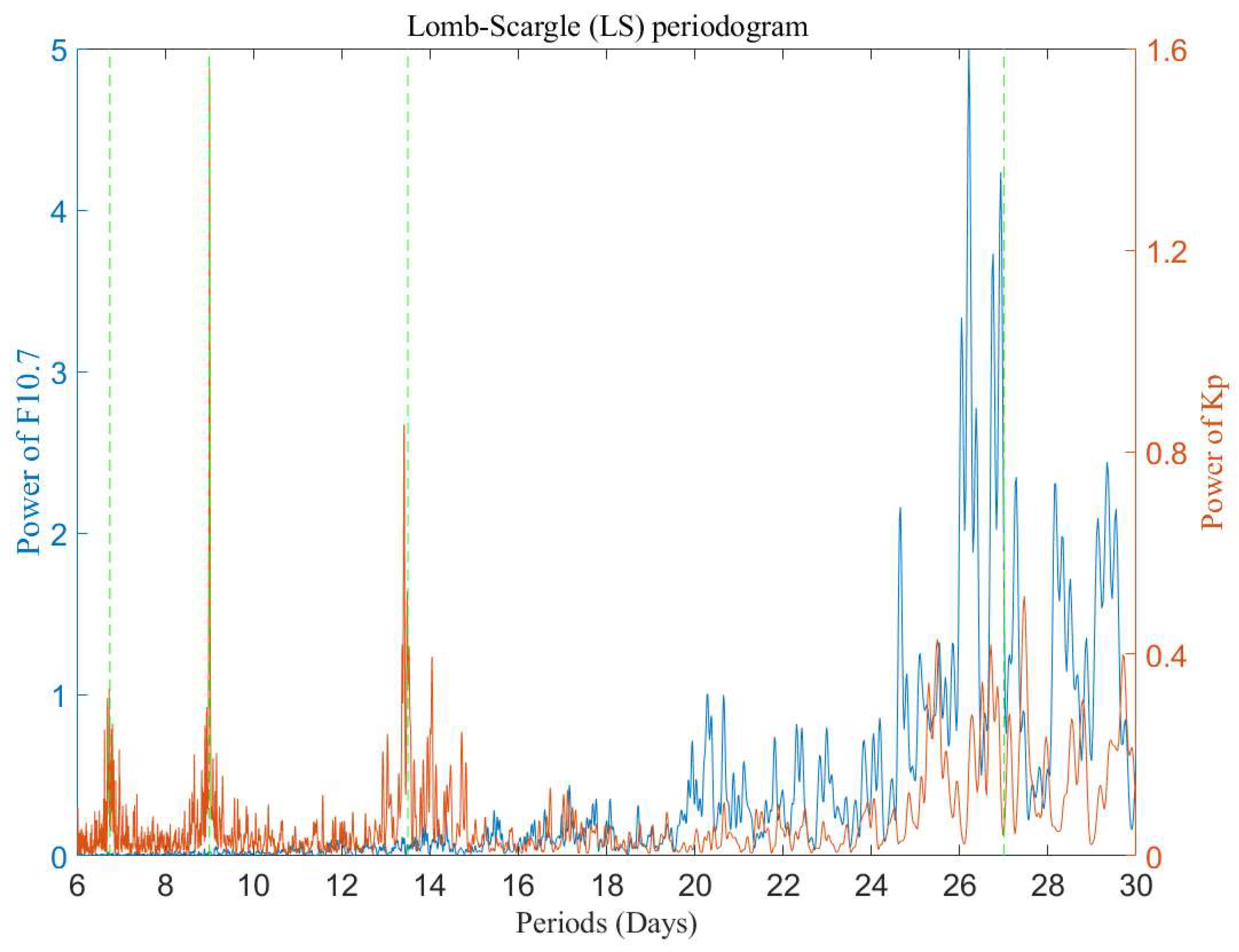
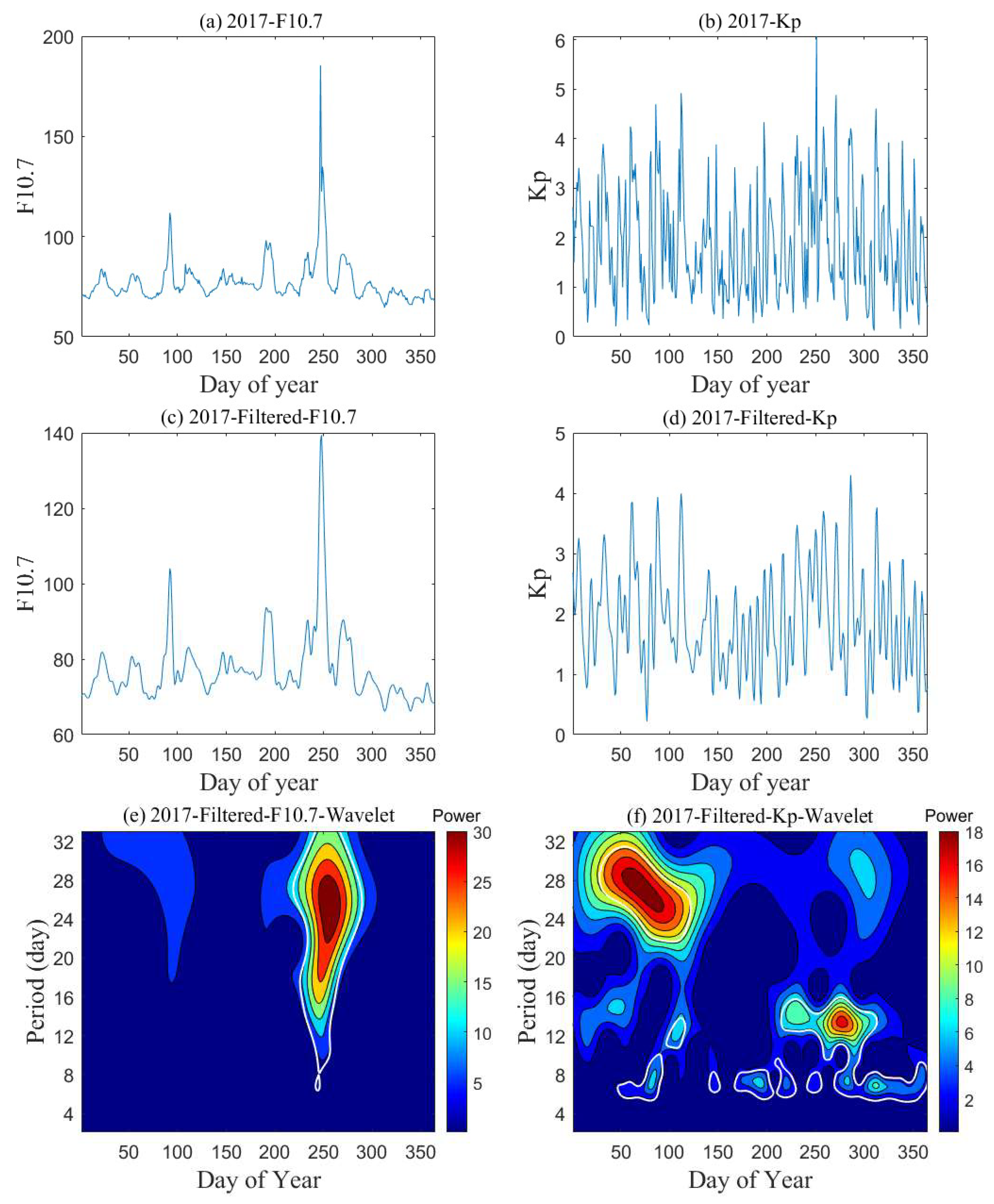
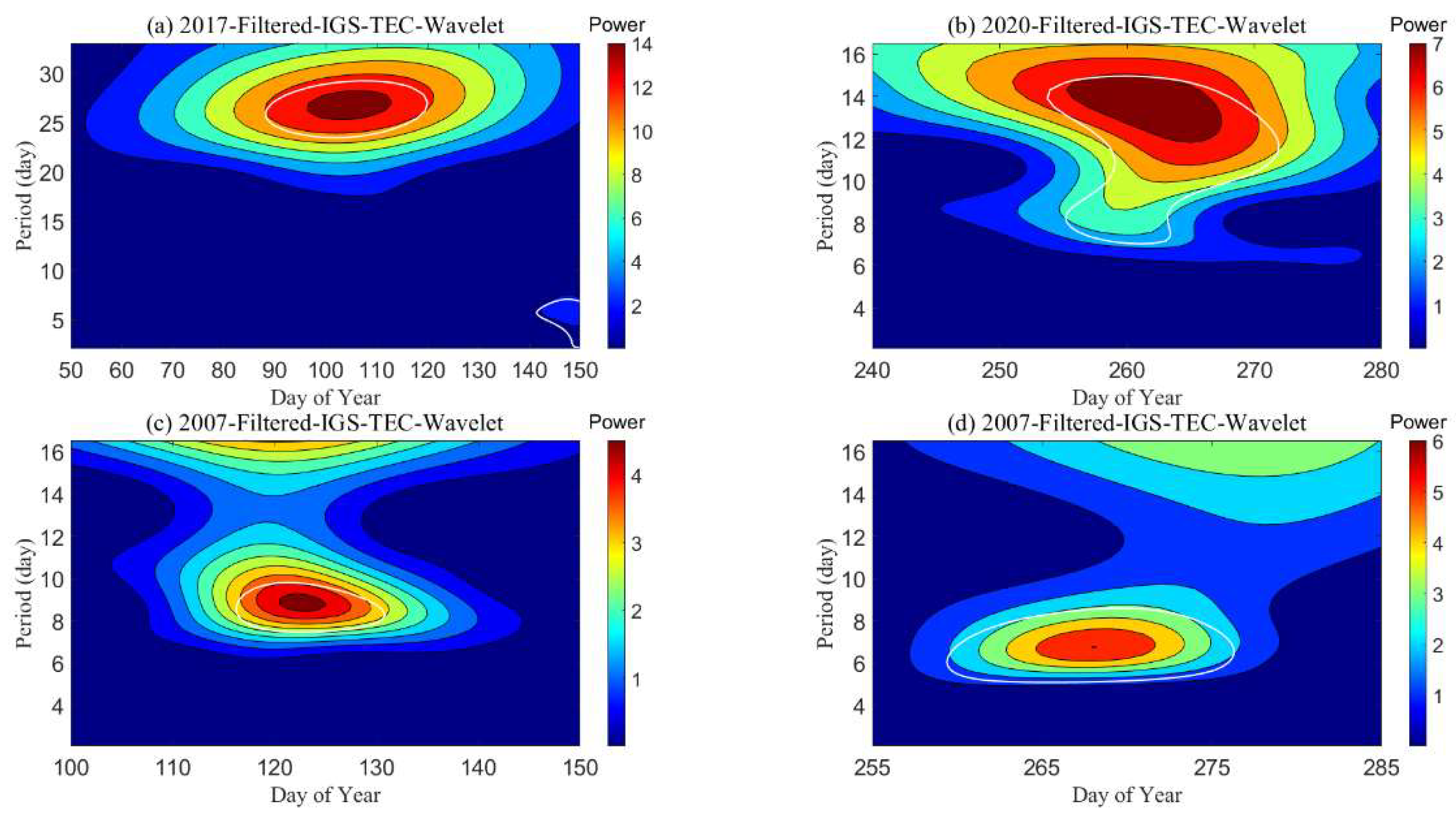

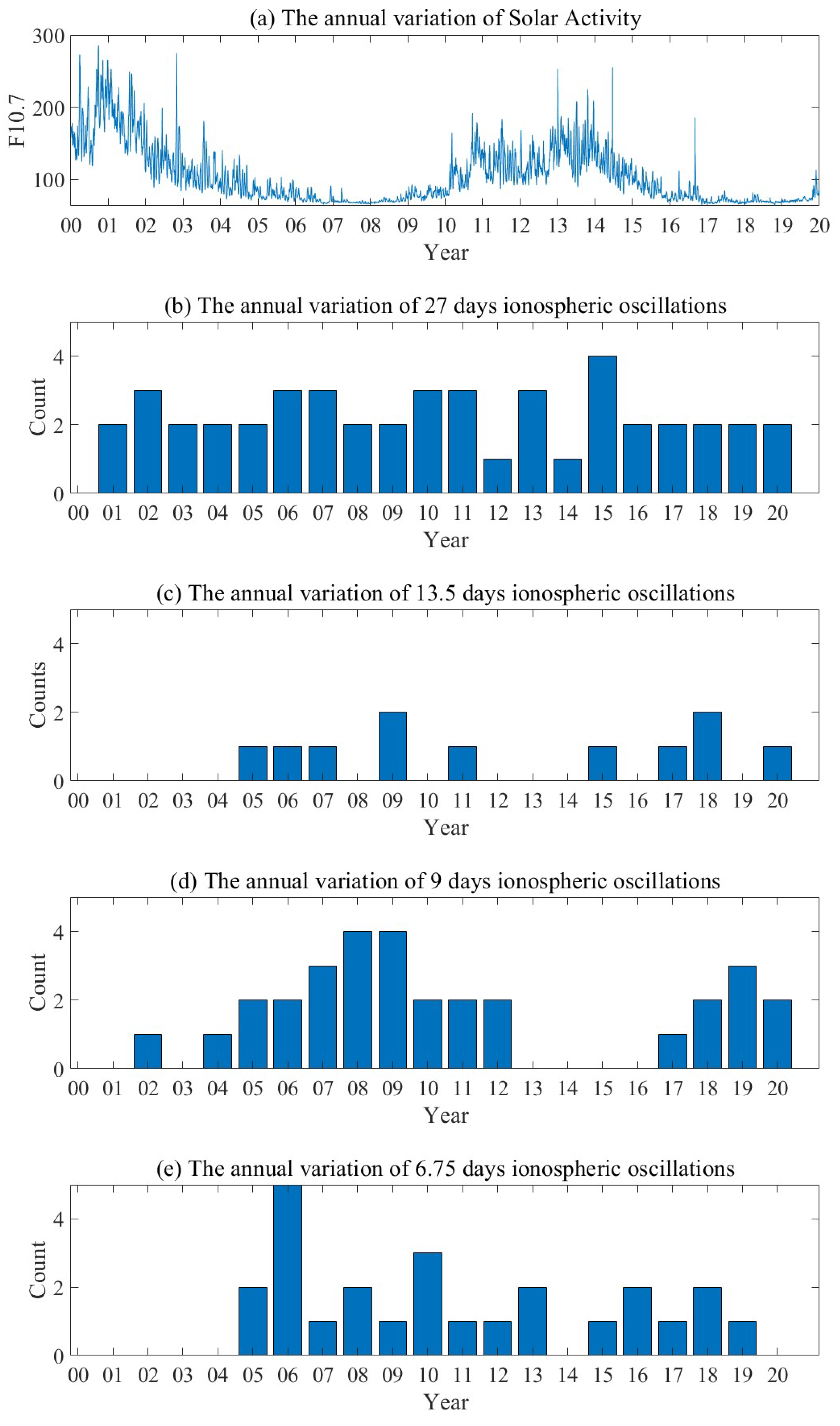
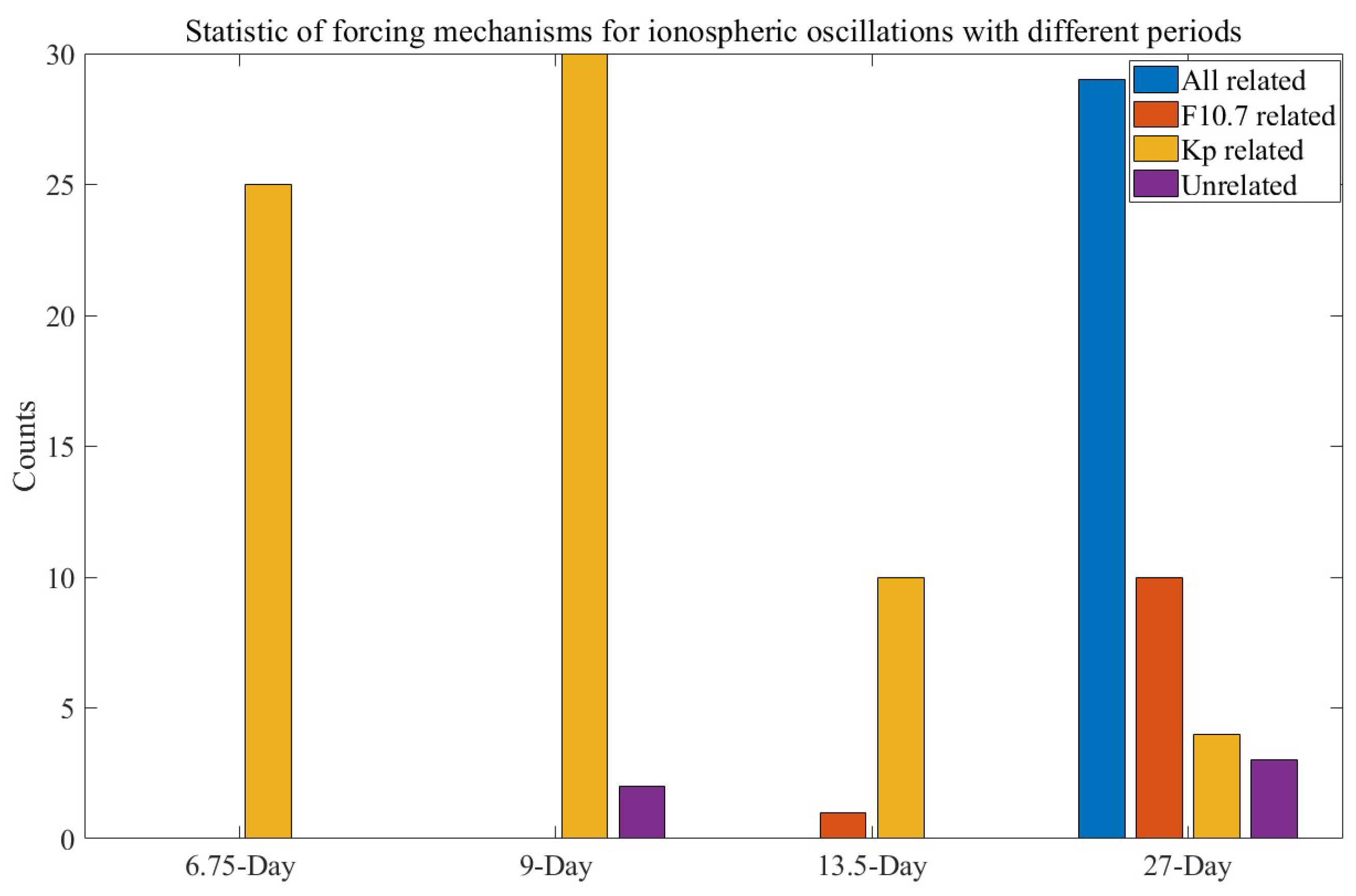
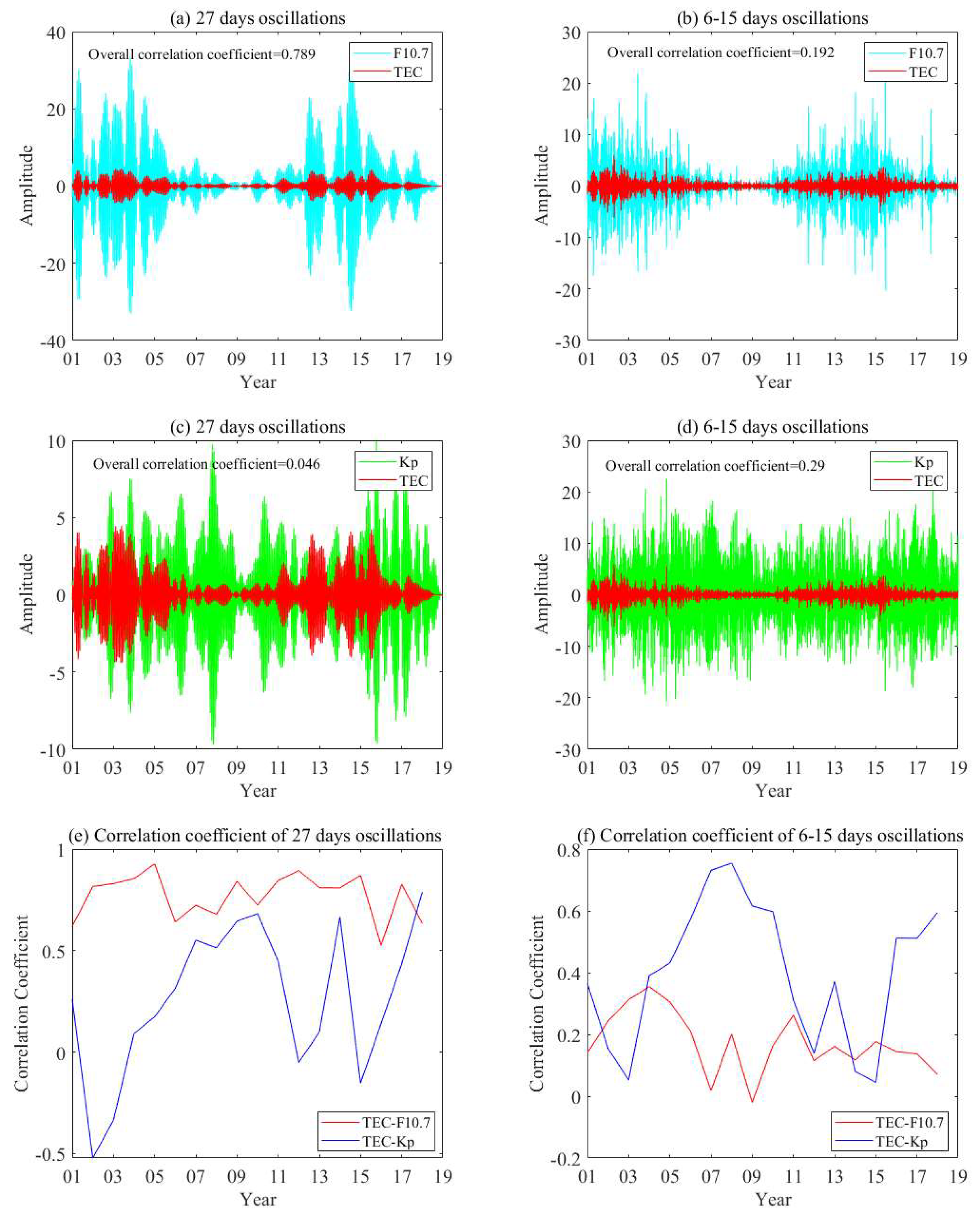
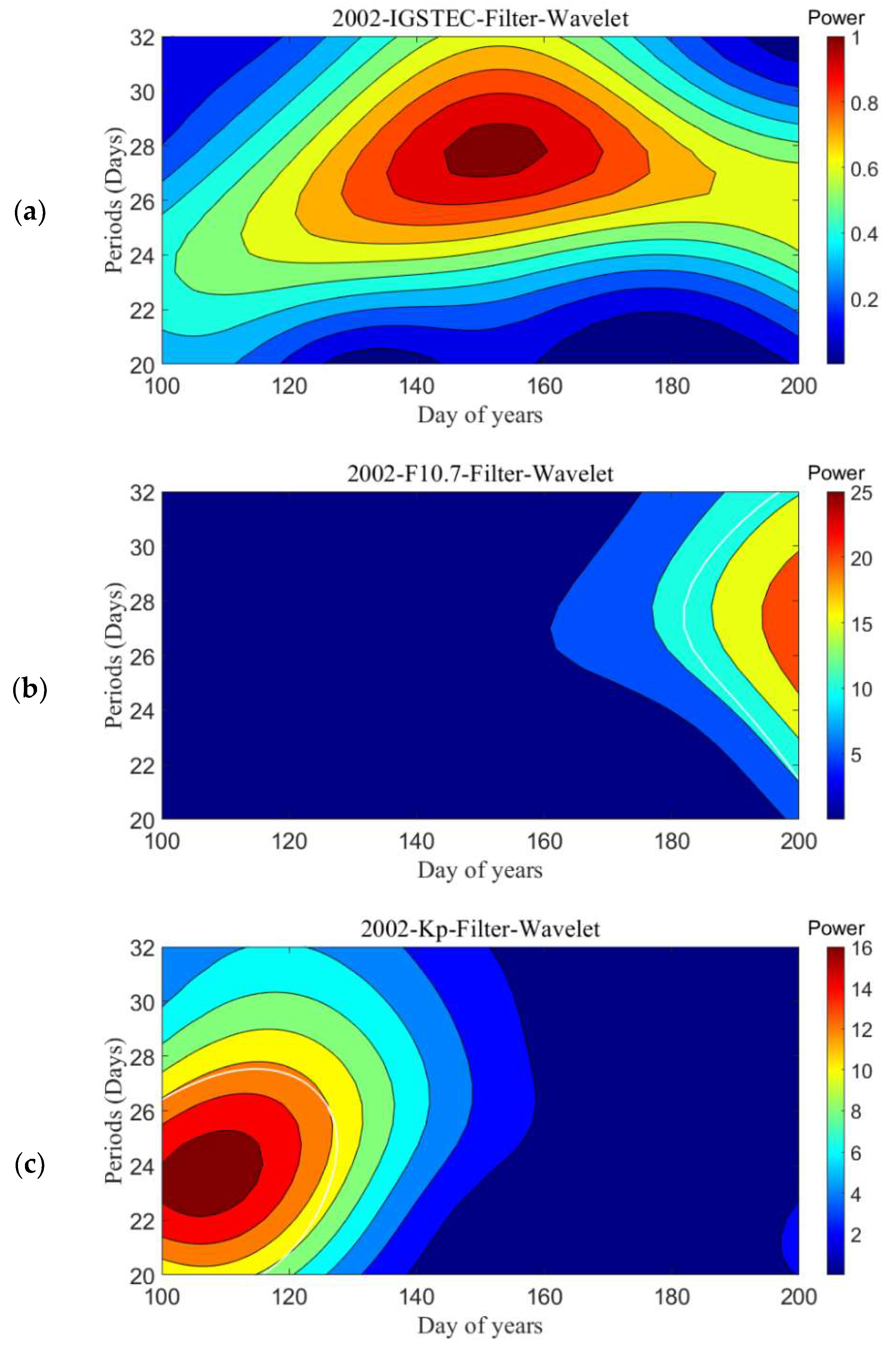
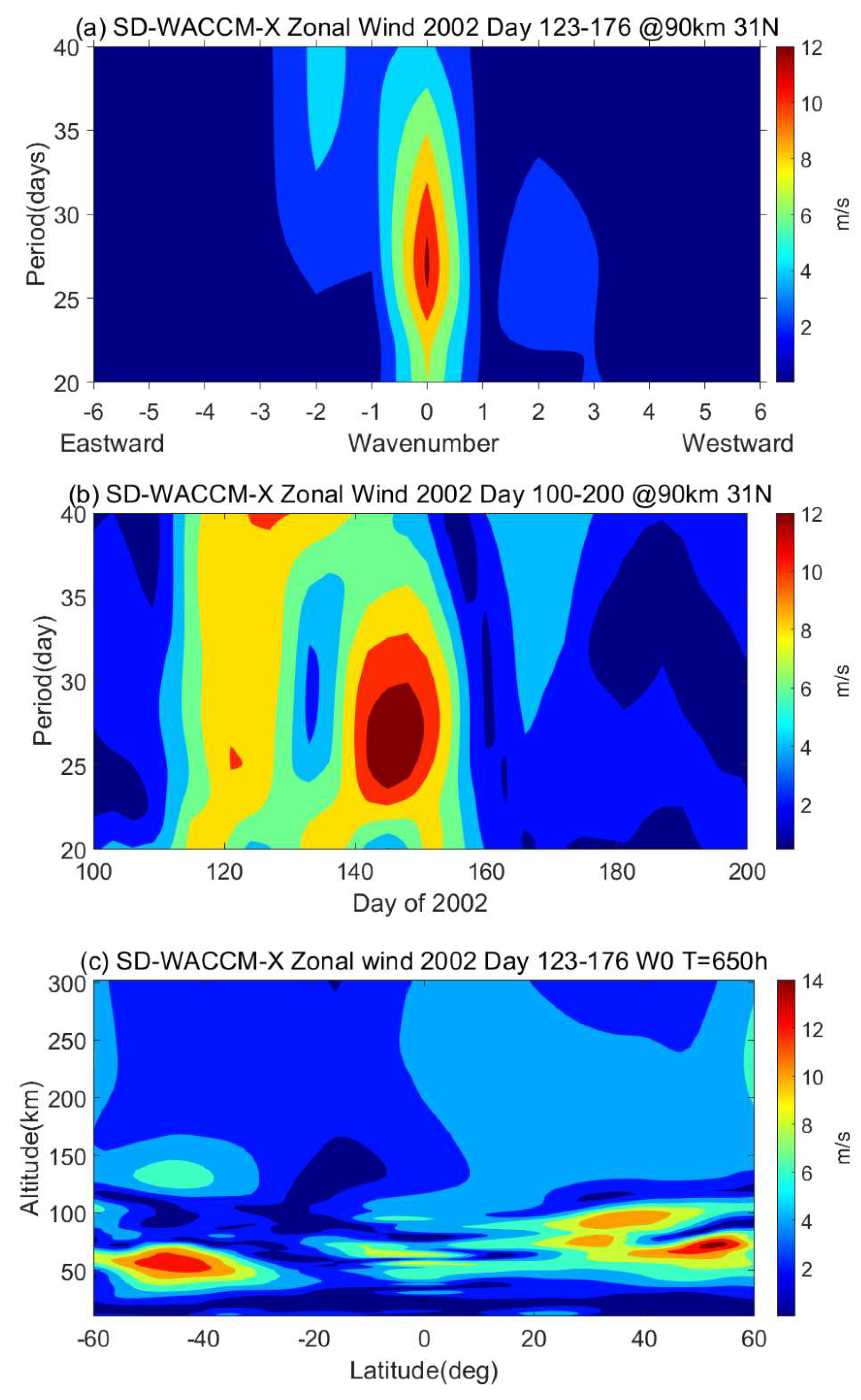

Publisher’s Note: MDPI stays neutral with regard to jurisdictional claims in published maps and institutional affiliations. |
© 2022 by the authors. Licensee MDPI, Basel, Switzerland. This article is an open access article distributed under the terms and conditions of the Creative Commons Attribution (CC BY) license (https://creativecommons.org/licenses/by/4.0/).
Share and Cite
Yang, Z.; Gu, S.-Y.; Qin, Y.; Teng, C.-K.-M.; Wei, Y.; Dou, X. Ionospheric Oscillation with Periods of 6–30 Days at Middle Latitudes: A Response to Solar Radiative, Geomagnetic, and Lower Atmospheric Forcing. Remote Sens. 2022, 14, 5895. https://doi.org/10.3390/rs14225895
Yang Z, Gu S-Y, Qin Y, Teng C-K-M, Wei Y, Dou X. Ionospheric Oscillation with Periods of 6–30 Days at Middle Latitudes: A Response to Solar Radiative, Geomagnetic, and Lower Atmospheric Forcing. Remote Sensing. 2022; 14(22):5895. https://doi.org/10.3390/rs14225895
Chicago/Turabian StyleYang, Zhenlin, Sheng-Yang Gu, Yusong Qin, Chen-Ke-Min Teng, Yafei Wei, and Xiankang Dou. 2022. "Ionospheric Oscillation with Periods of 6–30 Days at Middle Latitudes: A Response to Solar Radiative, Geomagnetic, and Lower Atmospheric Forcing" Remote Sensing 14, no. 22: 5895. https://doi.org/10.3390/rs14225895
APA StyleYang, Z., Gu, S.-Y., Qin, Y., Teng, C.-K.-M., Wei, Y., & Dou, X. (2022). Ionospheric Oscillation with Periods of 6–30 Days at Middle Latitudes: A Response to Solar Radiative, Geomagnetic, and Lower Atmospheric Forcing. Remote Sensing, 14(22), 5895. https://doi.org/10.3390/rs14225895






